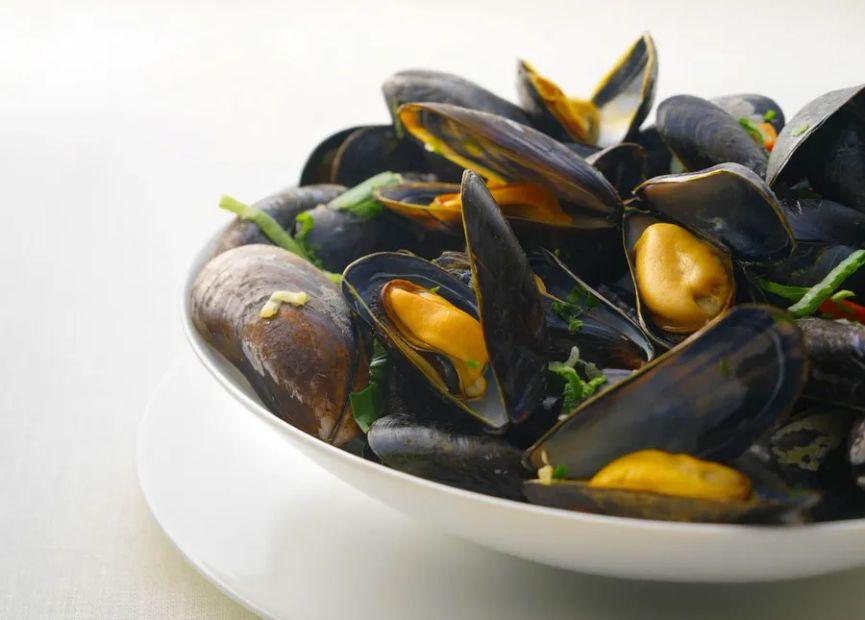The Complete Guide to Buying, Storing, and Cooking Mussels

Mussels are often a restaurant treat, but they’re actually one of the simplest seafood dishes to prepare at home. In fact, they’re easier to cook than salmon! Don’t let their small, almond-shaped shells intimidate you—learn all the tips you need right here.
What Are Mussels?
Mussels are bivalve mollusks, closely related to clams, oysters, and scallops. These saltwater creatures thrive in habitats along the Atlantic coast, stretching from Virginia all the way up to the Arctic.
Mussels have longer, more delicate shells that can chip easily, so they are not shucked. Instead, they are steamed open to reveal their plump, briny meat, which can be enjoyed as is, added to a stew, or even pickled.
What Is the Flavor of Mussels Like?
Mussels have a delicate, mildly sweet flavor with an elegant finish. They aren’t overly salty, and their texture is reminiscent of a meaty mushroom. Be careful not to overcook them, as they can turn rubbery and tough.

Find the recipe: Chef John's Cioppino
Different Types of Mussels
Most mussels are farmed, oval-shaped, and have a dark blue-black color. There is also a green variety found in Asia and New Zealand. Although freshwater mussels may resemble their saltwater cousins, they are a different species and typically aren’t consumed.
You’ve likely come across mussels labeled 'PEI.' This refers to the Prince Edward Island variety, which is the most common in stores. These mussels, known as Mytilus edulis, are recognized for their blue shells and are farmed in Canada's largest producing region.
Mussels vs. Clams
Clams are rounder, light gray or off-white, and have a sweet, slightly salty taste with a noticeable mineral flavor. Their flavor often reflects the waters they were harvested from.
Mussels are elongated, oval-shaped, and dark blue or greenish-black in color. They are usually cultivated in controlled environments, which means their size and flavor are more consistent.
How to Prepare Mussels
If the mussels you bought have 'beards'—those stringy strands sticking out of the shells—simply pull them off or use kitchen shears to trim them away.
You may have heard of 'sandy mussels,' but the ones you buy in stores are usually cleaned through a thorough process that removes the grit, so you won’t need to worry about it.

Find the recipe: Mussels Vinaigrette
Go through your mussels and discard any that are open, cracked, or discolored. If you find one that’s slightly open, tap it gently—if it doesn’t close, it’s best to toss it. They should be fully closed and smell fresh, like the sea, without any fishy odor. If anything smells off, throw it away.
For a simple preparation, place the mussels in a dry pan, cover, and cook over medium-high heat until they open. Once opened, stir in butter and pepper for flavor. The mussels will provide all the salt you need with their naturally briny juices.
Mussels are delicious when steamed with a splash of white wine and garlic—it's a classic dish for a reason. Just remember not to add too much liquid. You’re steaming, not boiling.
Where to Purchase Mussels
If you have a well-stocked local grocery store, you can find mussels at the seafood counter. If not, a specialty seafood market is your best bet.
Plan for about ¾ to 1 pound of mussels per person, depending on whether you're serving them as an appetizer or a main course. Pro tip: Buy more than you think you'll need, as some will be discarded for cracks, discoloration, or failure to open during cooking.
How to Keep Mussels Fresh
Mussels are alive when you buy them, and it's important to keep them that way. Unlike other proteins that can sit in the fridge until you're ready to cook them, dead mussels should never be served.
Store your mussels in the fridge in their original bag, usually made of mesh or netting. For extra freshness, wrap the bag in a wet paper towel or newspaper. Cold and moist conditions are key to keeping them alive, just as they would be in their natural environment.
Resist the urge to treat mussels like a goldfish. Storing them in water or sealing them in a plastic bag or container will suffocate them.
Mussels can be kept on ice, but if you do, place them in a metal colander inside a bowl and check them regularly. Avoid freezing mussels.
Evaluation :
5/5



